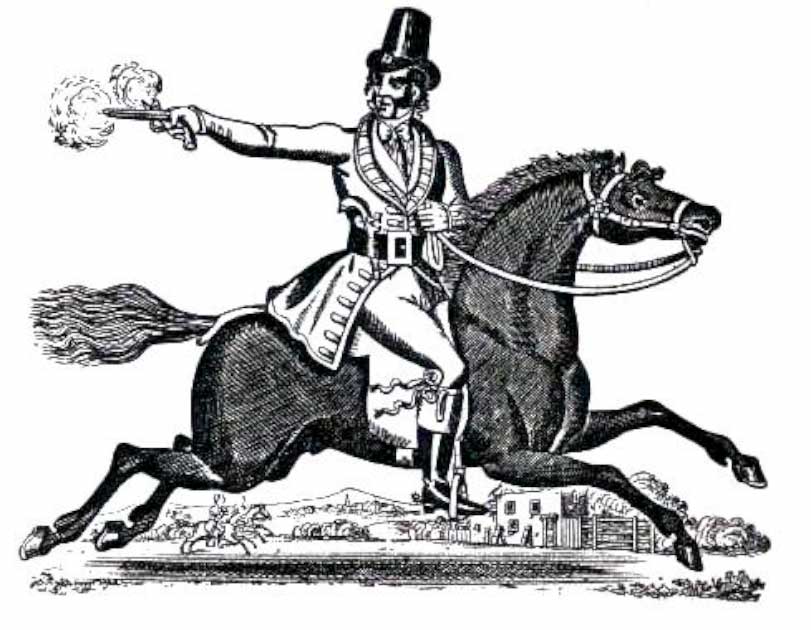Can a highwayman and thug be a real-life Robin Hood, or is the tale of Dick Turpin just a figment of popular imagination? Read on to know more.
Our collective fascination with Robin Hood-like figures runs deep. Stories of those who rob from the corrupt rich are common and, with their various fictional embellishments to add color to the tale, they permeate our collective consciousness.
However, unlike Robin Hood himself some of these characters are definitely real, and relatively well known as historical figures. The character of Dick Turpin is one such, a highway robber who would ambush stagecoaches on dark country lanes before escaping on horseback. But here the tale of a good-hearted highwayman living a glamorous, dangerous life can be compared to what is known in reality.
So was Dick Turpin as exciting as his romanticized reputation suggests? Or was he nothing more than a common thug?
The Legend of Dick Turpin
The story of 18th-century Dick Turpin in popular English literature is one of fantasy and glorification. In these stories, Dick Turpin is a flamboyant and fearsome highwayman who rode a beautiful black horse named Black Bess and did some impressive heroics. This depiction struck a chord with the public and lingered in the collective memory long after he was gone.
However, as with many historical stories that have been passed down generations, the story of Dick Turpin is a glorified account of a rogue. The most famous exploit of his is a midnight ride from London to York where he covered 200 miles (320 km) in one single day.
However, in truth, he never made the journey as described, with the account being created almost a century later by a Victorian novelist. In fact did not own a jet black horse named Black Bess, and many of the stories which surround him were later inventions as he became a blank canvas for imaginative Victorians to fill with whatever suited their Gothic or Romantic sensibilities.

The actual man was quite different. Richard “Dick” Turpin originally hailed from the Essex village of Hempstead and turned to criminal ways from a young age. Before he turned into a criminal and thief, he was a butcher just like his father.
- England’s Great Outlaw, Robin Hood: Real or Legend?
- William Tell: Is there a Real Man Behind the Myth?
However, in the 1730s, Turpin joined a gang of thieves and became a criminal. His journey as a criminal may have started from stealing deer and horses in the 1730s, but his crime evolved into poaching, looting, and eventually even murder. Although there are many romanticized tales revolving around his character in folk literature, his crimes were anything but rosy.
Turpin had a short life due to his criminal activities, and finally, in 1739, he was executed in his early 30s for stealing horses. However, it was in stories and poems such as Rookwood and Hanged in York that the character of Dick Turpin was glorified after his death.
The Gregory Gang
According to historical accounts, the gang Turpin joined was the Gregory Gang, named after its head thief Gregory. During Dick Turpin’s association with the Gregory Gang, his criminal stature increased: it was here that he learned his trade.
He started with cattle and horse stealing. As he was once a butcher, his experience came in handy for the gang in such activities, as he could break down the meat. He then also indulged in robbing houses and terrorizing families in and around Essex.
In some accounts, historians have talked about how he once robbed a wealthy man’s farmhouse and attacked the owner by pouring hot water over him. He is also believed to have raped a woman while raiding the farmhouse.
While he was living, he was never glorified in the way that happened after his death. Instead he was identified as the criminal that he actually was. He is also believed to have thrown an old lady into a fire. His first recorded cold-blooded murder was of killing a servant who had identified him as a thief and criminal.
Although Turpin first operated in association with a gang, the gang was soon caught and executed. However, Turpin was lucky as he escaped from captivity in the nick of time. He then became a highwayman. For a brief time, he stayed in a cave in Epping Forest near London and collaborated with another criminal, Thomas Rowden.
Was Turpin Like Robin Hood?
It is possible that the idea that Turpin was a Robin Hood-like figure arose from his stay in the Epping Forest because Robin Hood also famously lived in a forest on the outskirts of a populous city. Much like Robin Hood, Turpin and his accomplice used to stop people who passed through the forest on their way to London and robbed them of money.
However, the money he made from this was not a huge amount, and Turpin soon tired of living in a cave. However, he did not leave the criminal way of life behind and continued to commit many crimes. He only changed his company and joined hands with another famous criminal, Tom King.

Together the two robbed many rich people and stole horses too. However, their partnership did not last for a long time, as King was mortally wounded in a fight over a stolen horse. According to some historians, the wound that killed King was given by his partner, although the shot may have been fired accidentally.
Towards the end of his short life in the late 1730s, Turpin was mostly alone. Most of his accomplices and friends, including his wife, were either dead or in jail. It is possible that, before the end, Turpin may have seen the cost of the lifestyle he chose, and come to appreciate the loss of his friends.
After the death of Tom King, Turpin must have decided to lie low and went into hiding at his familiar Epping Forest. It was there that he was spotted by a servant who identified him and tried to capture him single-handedly.
However, the servant was no match for Turpin, and he killed the servant to save himself from capture. After committing two murders in a row, Turpin fled to Yorkshire under the false identity of John Palmer. While many believe that he made this escape on his beloved horse Black Bess in one ride, in truth, he fled from Epping Forest on a ferry.
Although Turpin assumed a false name and tried to lay low, he was finally arrested in 1738 because of a few petty crimes. After his capture in Yorkshire, he was accused of shooting a rooster and stealing a few horses. In April 1739, he was executed in York.
Although he was accused of so many crimes and was captured, he did not show any signs of remorse or self-pity. He remained happy even in captivity, and his behavior just before his execution was one of a showman who was taking his final bow. Perhaps he had made his peace with the short lie of a highway robber after all.

His flamboyant behavior and public curiosity might have given rise to the legends after his death. In reality, Turpin died in a painful manner, alone. But the dignity with which he carried himself, even in death, may have sparked his posthumous reputation and turned him into the figure we know today.
Top Image: Highwaymen were a figure of fascination, and Dick Turpin is the most famous of them all. Source: Edgar Alfred Holloway / Public Domain.
By Bipin Dimri